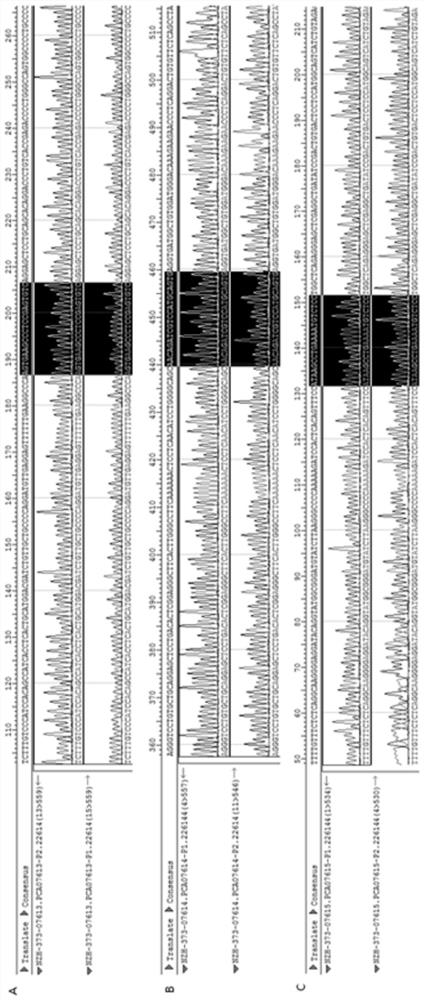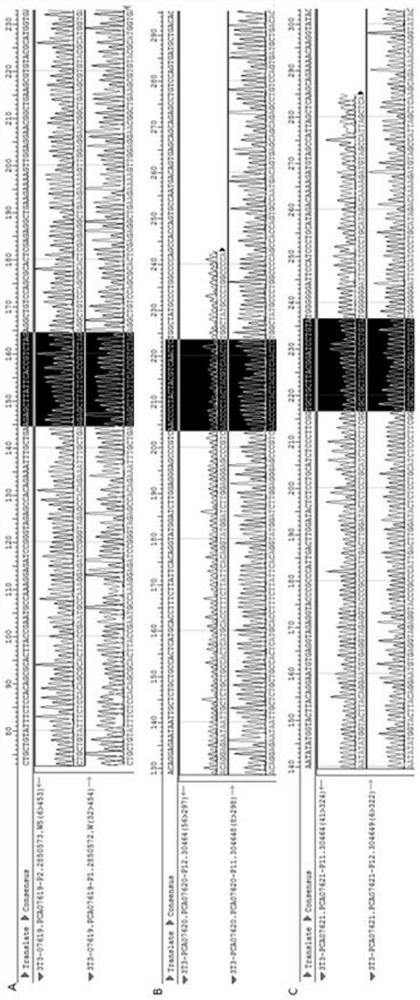Method for constructing in-situ liver cancer animal model
An animal model, in situ technology, applied in the field of animal models, can solve the problems of being unsuitable for the immune system, high technical requirements, and high mortality in modeling, and achieve the effect of shortening the tumor formation time and improving the tumor formation rate.
- Summary
- Abstract
- Description
- Claims
- Application Information
AI Technical Summary
Problems solved by technology
Method used
Image
Examples
Embodiment 1
[0038] 1. Target gene sgRNA design.
[0039]According to the gene sequence of PTEN or AXIN1 or TRP53, the sgRNA of PTEN or AXIN1 or TP53 was designed and synthesized according to the sgRNA design website (http: / / crispr.mit.edu / ). The specific sgRNA sequences of each gene are as follows. Three sgRNAs were designed for each gene and synthesized by Sangon Bioengineering (Shanghai) Co., Ltd.
[0040] Table 1 sgRNA
[0041]
[0042]
[0043] PCR primers were designed according to the sgRNA sequence, and the cellular genomic DNA was used as the template for PCR amplification, and the PCR products were sequenced to determine whether there was a SNP site in the target genome position bound by the sgRNA, and to determine the possibility of off-target. details as follows:
[0044] 1.1Trp53 gene
[0045] (1) Trp53 target design
[0046] Table 1
[0047]
[0048] (2) SNP detection primers in Trp53 target region
[0049] Table 2
[0050]
[0051] (3) PCR reaction system ...
Embodiment 2
[0137] Construction of pX330-U6-sgRNA(PTEN or Axin1 or TP53)-Chimeric_BB-CBh-hSpCas9-T2A-mCherry plasmid
[0138] 1. Transformation of pX330-U6-Chimeric_BB-CBh-hSpCas9 plasmid
[0139] The T2A-mCherry gene was cloned into the pX330-U6-Chimeric_BB-CBh-hSpCas9 plasmid (see the plasmid map Figure 11 )middle.
[0140] (1) The pX330-U6-Chimeric_BB-CBh-hSpCas9 plasmid was digested with EcoRI enzyme to be linear, and electrophoresis was used to observe whether the digestion result was linear.
[0141] (2) PCR amplification of T2A-mCherry target gene
[0142] The primers are as follows, and the end of the primer introduces an EcoRI restriction site,:
[0143] Table 13
[0144]
[0145] Primer description: It contains exchange paired bases, restriction enzyme sites, and contains part of the 5'-end sequence of the target gene for PCR to fish for the target gene.
[0146] Using the original plasmid with T2A-mCherry as a template, the above-mentioned primers were used to amplify ...
Embodiment 3
[0183] According to the above examples 1 and 2, 3 sgRNAs of PTEN or AXIN1 or TP53 gene have been successfully cloned into the CRISPR / Cas plasmid system, and the mouse liver cancer cells were transfected with T7 endonuclease I (T7E1) enzyme. Excision activity screening produces sgRNAs with stronger editing ability for target genes. The specific operation steps are as follows:
[0184] (1) Identification of sgRNA editing ability by T7E1 digestion
[0185] Enzyme digestion system: purified product 4-7μL (purified product at 500ng), Detecase Buffer 2μL, Detecase 0.5μL, ddH 2 O make up volume 20 μL. After 60 min of reaction at 37°C, 2 μL of Top Buffer was added to the above 20 μL system immediately.
[0186] (2) Trp53 gene
[0187] Table 21 sgRNA editing ability T7E1 digestion
[0188]
[0189] PCR reaction system for SNP detection in Trp53 target region: 1 μL of upstream and downstream primers (10 μM); 25 μL of 2×Taq Plus Master Mix; 2 μL of Genomic DNA (>200ng / μL); ddH 2...
PUM
 Login to View More
Login to View More Abstract
Description
Claims
Application Information
 Login to View More
Login to View More - R&D
- Intellectual Property
- Life Sciences
- Materials
- Tech Scout
- Unparalleled Data Quality
- Higher Quality Content
- 60% Fewer Hallucinations
Browse by: Latest US Patents, China's latest patents, Technical Efficacy Thesaurus, Application Domain, Technology Topic, Popular Technical Reports.
© 2025 PatSnap. All rights reserved.Legal|Privacy policy|Modern Slavery Act Transparency Statement|Sitemap|About US| Contact US: help@patsnap.com



